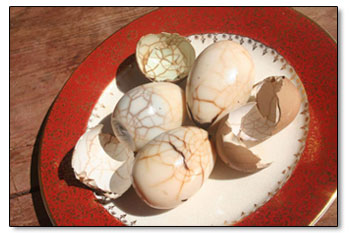|
|
Tea eggs, for Passover, Easter, etc.by Ari LeVaux But “Stock up on eggs for Passover and Easter” was always different. It seemed both completely absurd, as one would expect from bad English T-shirt poetry, but also true. It felt like it was trying to tell me something. Eggs are, in fact, integral to both Passover and Easter, and if one wanted to celebrate either, one would, in fact, want to stock up on eggs. So there is that. Of course few people celebrate both, but the shared egg hints at the fact that the two holidays are celebrating similar things. Both explore issues of birth and death and rebirth. And the egg is a powerful symbol of the transition into life. Spring is also an important season for another egg-worshipping tribe, the locavores – especially the backyard chicken farming subset. The egg symbolizes a vibrant backyard ecosystem. It is a joyous morsel of cruelty-free animal protein and a constant reminder how awesome it is to give your food waste to a chicken instead of a compost pile. But while eggs are definitely a goal in the raising of backyard chickens, the chicken comes first, according to Harvey Ussery in The Small-Scale Poultry Flock. And this is true both symbolically and literally. “Most beginning flocksters start with the chicken – either just-hatched chicks, started birds just out of the brooder up to onset of lay, or adult birds – though a few go-getters might prefer to start by hatching eggs in an incubator.” Most hatcheries begin selling baby chicks in March, either as direct orders to consumers or to feed stores. Of course, chickens these days can be coaxed into laying eggs all year round. And new chicks can be incorporated into a flock at any time. But from a chick’s perspective, spring and summer is a great time to grow up. By the same token, hatcheries don’t like selling chicks in fall or winter, because too many of them die. My first batch of mail-order chicks arrived in the mail on Easter Sunday 2002. You might be thinking, “Wait, the mail doesn’t even come on Sunday, much less Easter Sunday.” In fact, the minute a shipment of live animals arrives at a post office, the recipient is notified, 24/7. It was about 8:30 p.m. on Easter Sunday when I got the call. I had to use the post office’s back door. Ordering chicks through the mail gives you a lot of options in terms of the many fancy and funky breeds of chicken out there. At the same time, there’s something fun about going to the local feed store and rolling the dice on whatever they have in stock. I’ve had great luck with random feed store chicks. Of the common breeds, you can’t go wrong with the bright gold Buff Orpingtons. So while followers of biblical religions should consider stocking up on eggs for Passover and Easter, for those more inclined toward Earth Day, it’s time to stock up on baby chickens. If you are stocking up on chickens this time of year, you could do a lot worse than have Ussery’s book on your shelf. It’s an informative and entertaining read, and speaks to almost any question you could have about backyard poultry raising. Had I had his comprehensive opus when I was getting started, it would have saved me a lot of wrong turns and expanded my vision of the many ways that the personal flock can be integrated into the home ecosystem. Luckily, it’s never too late to explore the chicken and the egg. In honor of egg season, and in service of general egg appreciation, I will leave you with an egg recipe. I was tempted to go with a Filipino dish I once tried called balut, which consists of a fertilized egg that is cooked and eaten a few days short of when it’s ready to hatch – usually before the feathers form. The egg is simmered, opened and salted. It tasted like chicken soup, and is a great way to draw focus to what an egg really is. But given the recipe involves the step of incubating fertilized eggs, I decided to go with something simpler. Tea Egg This is a popular Chinese New Year dish. Tea eggs are pretty, like Easter eggs. And like Passover eggs, they are salty – thanks to the soy sauce.
|


